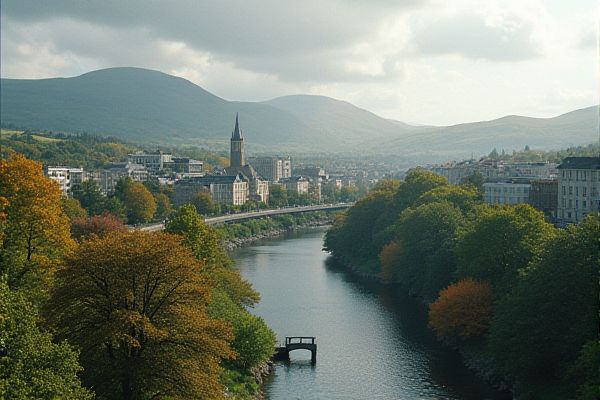
Dining and food culture in Ireland: Traditional Irish breakfast. Guinness stout significance. Afternoon tea tradition. Pub culture importance. Local produce emphasis. Seafood specialties. Potato-based dishes. Farm-to-table dining. Popularity of Irish whiskey. Seasonal festivals and feasts.
Traditional Irish breakfast
A traditional full Irish breakfast includes bacon (rashers), sausages (bangers), fried eggs, baked beans, mushrooms, tomatoes, hash browns, and often black or white pudding, all typically cooked in a frying pan and served with soda or brown bread and tea. This hearty meal was traditionally prepared to provide energy for a long day of work, especially on farms. For more detailed information and recipes, visit the website Happy Foods Tube. This meal has become emblematic of Irish hospitality, offering a warm welcome and robust start to the day.
Guinness stout significance
Guinness Stout is a seminal part of Irish culture and history, having been brewed at St. James's Gate Brewery since 1759 and becoming an iconic symbol of Ireland, celebrated for its rich, roasted aroma and creamy texture, and integral to the country's culinary and social traditions. It is a must-taste for visitors and a staple in Irish pubs, reflecting the country's brewing heritage and tradition.
Afternoon tea tradition
Afternoon tea in Ireland is typically served between 3 and 5 PM, often accompanied by a not too sweet cookie as part of a broader tea culture. This rich tradition includes traditional teas at 11 AM enjoyed with scones, and continues with High Tea at 6 PM featuring various trimmings. To learn more about this delightful custom, you can visit the Farmers' Almanac for an insightful perspective on how the Irish uniquely embrace their tea rituals.
Pub culture importance
Irish pubs are central to the country's dining and food culture, serving as more than just places to grab a drink; they are community hubs where people gather for traditional music, local food, and social interactions, making them integral to Irish life and identity. These establishments exude a warm and inviting atmosphere that epitomizes the spirit of Ireland. For those planning to explore the vibrant pub scene, it's worth checking out the comprehensive guide on Travel See Write, which highlights the must-visit pubs and the unique experiences they offer. Whether you're a first-time visitor or a seasoned traveler, the charm of an Irish pub is an essential part of experiencing the rich cultural tapestry of the Emerald Isle.
Local produce emphasis
Irish cuisine places a strong emphasis on locally sourced ingredients, including high-quality dairy, beef, and seafood, with a focus on farm-to-table dining and fresh, seasonal produce, which has elevated the country's culinary scene and supported local farmers. Today, Ireland's culinary approach has shifted towards a more sustainable farm-to-table movement, utilizing locally-grown produce to create a more authentic and fresh dining experience, reducing food waste and supporting local farmers. For those interested in exploring these culinary developments further, The Ultimate Foodies Guide to Ireland offers a comprehensive insight into the diverse and evolving food culture of Ireland. This movement not only showcases the richness of Irish ingredients but also plays a crucial role in supporting the local farming community.
Seafood specialties
Ireland's seafood culture is rich and diverse, featuring popular dishes like fish and chips with haddock, cod, and pollock, as well as delicacies such as smoked salmon, monkfish, and various shellfish like oysters, mussels, and Dublin Bay prawns. These seafood delights are often prepared through a combination of traditional and contemporary methods. Dive into the assortment of Irish Seafood Dishes to explore the blend of flavors and culinary techniques that highlight the region's renowned marine bounty.
Potato-based dishes
Irish cuisine is deeply rooted in potato-based dishes, such as Colcannon (mashed potatoes with cabbage or kale), Boxty (potato pancakes), Champ (potatoes with scallions), and Irish Potato and Leek Soup, reflecting the historical significance of potatoes as a staple food in Ireland due to their nutritional value and ease of cultivation in poor soil. For more insights into these Uncommon Traditional Irish Potato Dishes, you can explore the history and variations of these cherished recipes that have been passed down through generations.
Farm-to-table dining
In Ireland, farm-to-table dining is a prominent culinary philosophy, with restaurants like The Strawberry Tree, Camus Field Kitchen, The Old Bank, and Cashel Palace emphasizing the use of locally sourced, organic, and seasonally available ingredients to create authentic and sustainable dining experiences. This approach celebrates the connection between food and its origins, supporting local farmers and promoting biodiversity and animal welfare.
Popularity of Irish whiskey
Irish Whiskey has seen significant growth, with sales in the U.S. surpassing 6 million nine-liter cases and dollar sales increasing by 5% in control states, driven by consumer preference for higher-end Irish whiskies and increased celebrations around St. Patrick's Day. For detailed insights on this trend, visit MarketWatch, where the analysis of market expansion sheds light on the evolving tastes of consumers and the factors contributing to this whiskey renaissance.
Seasonal festivals and feasts
Ireland's food culture is celebrated through numerous seasonal festivals, including the Galway International Oyster and Seafood Festival, Waterford Harvest Festival, Armagh Food and Cider Festival, and the Burren Slow Food Festival. These events highlight local producers, traditional and innovative Irish foods, and sustainable food practices. Often held in September, they showcase the country's rich culinary heritage and fresh, seasonal ingredients. Discover more about these vibrant events and the unique flavors they offer by visiting the Food Festivals that paint Ireland's gastronomic landscape.
